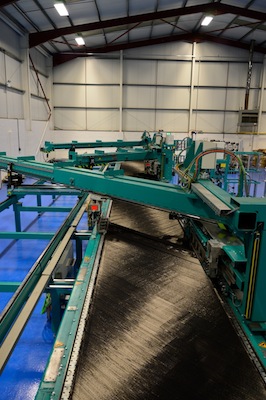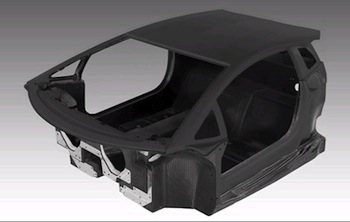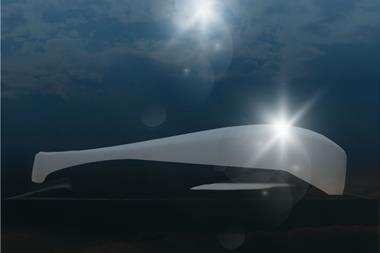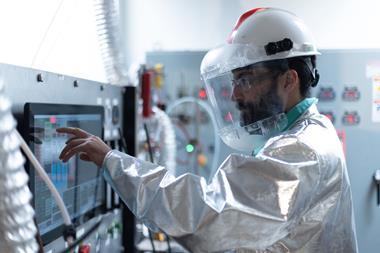Multiaxial reinforcement manufacturer Formax is tailoring lightweight materials to automotive needs
 If you think of carbon fibre you more than likely envision the familiar woven sheet, but there is more to this high-tech, lightweight material – as a visit to multiaxial reinforcement manufacturer Formax reveals. Based in Leicestershire, UK, the company uses an intricate and highly technical process to produces sheets of what it calls 'multiaxial reinforcement'. These differ fundamentally from woven materials in the way they are produced.
If you think of carbon fibre you more than likely envision the familiar woven sheet, but there is more to this high-tech, lightweight material – as a visit to multiaxial reinforcement manufacturer Formax reveals. Based in Leicestershire, UK, the company uses an intricate and highly technical process to produces sheets of what it calls 'multiaxial reinforcement'. These differ fundamentally from woven materials in the way they are produced.
The carbon fibre strands are arranged in parallel across a machine table, at a diagonal angle that varies according to the performance requirements of the finished material and its application. Each strand is positioned by a pin at either side of the table in an automated process, with these locators running the length of the table. The threads are fed from individual spools at one end of the machine, and the composition of the thread varies depending on the application.
Once a run of strands has been placed, a second layer is added at an opposing angle to the first. The layering process continues according to the application and performance requirements. When the final layer is in place, the material is stitched together to create a strong, highly flexible sheet. This method of production offers a highly drapable fabric which can be engineered to fit complex moulds. [sam_ad id=17 codes='true']
Formax develops and produces multiaxials for a wide range of industries and applications, including automotive, and managing director Oliver Wessely is keen to highlight the company’s ability to deliver relatively short runs. This very flexible approach to manufacturing, while serving customers well, presents some challenges for maintaining production flow. In particular, changeover from one specification to another is an extremely involved operation and can take several hours to complete. This results in a level of downtime that would would not be tolerated in high-volume automotive manufacturing, but in this high-tech field the need for flexibility is key – and something Formax prides itself on.
The company employs a variety of stitch-bonding, weaving, and laminating machines, from narrow width weaving looms through to 2.5 metre-wide multiaxials. The multiaxial machines are manufactured by Karl Mayer Malimo, and include 50" and 100" biaxials, 50" and 100" multiaxials, plus the latest generation of carbon cut-and-lay machines. Formax's woven UD fabrics are manufactured on re-engineered Dornier and F2001 weaving looms. However, the company does not simply buy off-the-shelf machines; a team of experienced engineers develops the machines by refitting them to improve efficiency and to accommodate new customer requirements.

Installed in a new 5,000 sq.m automotive facility at the company’s UK headquarters, the new cut-and-lay machine will be dedicated to the production of tailored Non Crimp Fabrics (NCFs) specifically optimised for high-volume automotive programmes.
The machine is equipped with three axes, capable of laying ply angles from 20° through to 90° with both in-line and off-line spreading technology, allowing engineers to specify larger, lower-cost, carbon fibre tows, with ply weights starting from just 50gsm. An additional feature of the machine is that it is equipped with electronic pattern cams. This allows the creation of fabric specific stitch patterns, which, together with Formax’s extensive research into simulating drape, provides the capability to tailor fabric for specific parts.
One recent client was Lamborghini, for which Formax developed a range of balanced materials combining drapeability and robust structural properties, and using an innovative method of binding the materials in a preform structure prior to injection. The resulting quadaxial structures, stitched with Formax’s "tacky-stitch” which is specifically designed for preform applications, were refined many times before the final, optimised version was used by Lamborghini to reinforce the chassis for its new carbon supercar, the Aventador.
AMS: What increase in demand from automotive customers have you experienced in the last five years?
Oliver Wessely (OW), managing director: We didn’t really have any demand for our products from the automotive sector five years ago, but the growth has been dramatic and now automotive represents 25% of our business.
Dan Norton (DN), automotive section manager: We saw the initial demand come from the supercar OEMs but now we are seeing more of a pull from the big, high-volume OEMs looking at building multi-material platforms using carbon composites. The new machine we installed will be supplying that growth.
OW: We are looking at a large part of the company’s future growth coming from supplying the automotive sector.
AMS: Has the type of product you are supplying changed in terms of application and specification?
DN: It’s changed a lot, shifting from just ‘we want this fabric’ requests, to working closely with composite and textile engineers now employed at the OEMs' facilities. They are learning what can be achieved – with our help – with these materials.
OW: Initially, a lot of the material we supplied was being used in crash structures but now we’re seeing demand for applications across the rest of the vehicle.
DN: For example, there’s now increasing demand for Class A body panels and we need to supply a good, flat, gap-free material that requires very little, if any trimming or finishing when going down the production line.
AMS: How closely do you work with your automotive customers when developing materials?
OW: It depends on the level of relationship. For example, we work very closely with our supercar customers. The larger OEMs tend to take more of an 'at arm’s length’ approach, meaning we have less influence on their choice of materials.
DN: Also, the high-volume OEMs are really only just starting to use composites in any meaningful way, and so are at the start of the learning curve. As they increase their use of these lightweight materials, companies like Formax will become more integrated as suppliers.
AMS: What are the technical demands from the OEMs?
OW: A big demand now focuses on the surface finish. So the question we’re often asked is: can our fabric be used on the outside surface of the panel and not ‘print through’ when it’s painted? This is a massive demand but one I think we are well placed to meet.
The other area I think will see a lot of demand is in drape simulation. So the customer will request a fabric but will want it to be very ‘drapable’ for a certain application. It is then down to us to use our expertise and experience to modify the properties and performance of the fabric to meet the needs of their process. This is very demanding work and is occupying much of our time.
AMS: What are the mechanics of this type of development?
DN: The customer will work out their CAE data and come to us with the structure they want to build and ask us for advice. In the first instance, we can usually identify areas where savings in cuts and material usage can be made. Then it’s providing the correct material, looking at the drapability, stitch style, etc.

OW: Yes we do, but it’s very dependent on the quality of the information you put in. If you use the right data then you can mimic the drapability of the material and identify how it will fold. We can then create a physical form and test the results, making modifications as required.
The stitch bonding – how the strands are held in place – is critical to the way the fabric will perform. Too tight and it will fold, too loose and it will ladder back and fibres will fall out. It’s achieving a fine balance between the two.
AMS: How do you monitor quality control? Do you use a vision system during production?
OW: We use monitors to enable the operators to view the process at key points but automated systems struggle to be accurate due to the glare from the carbon fibre. Quality is obviously very important and carbon fibre is an expensive material, so we work very hard to maintain high quality standards.






































